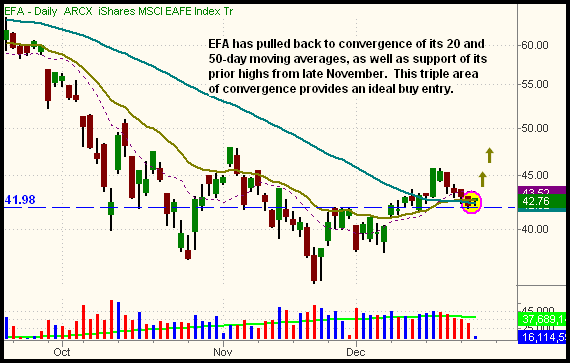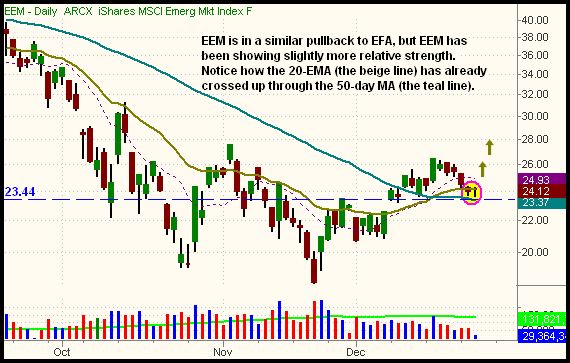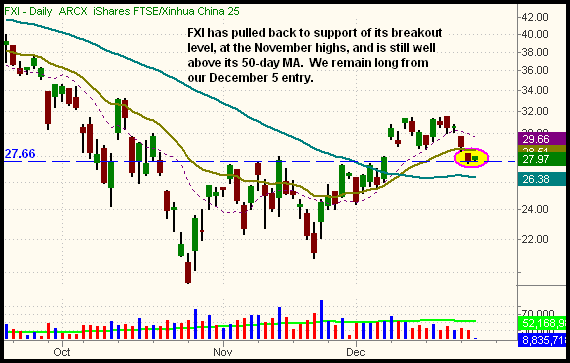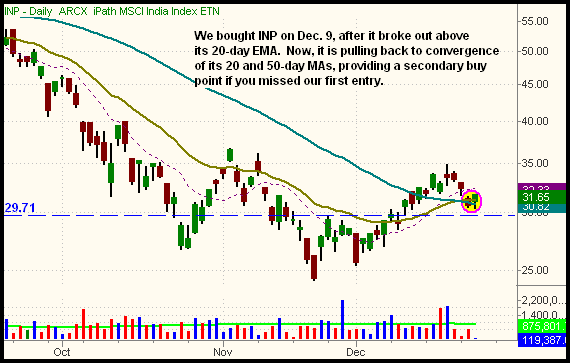|
The Wagner Daily ETF Report For December 26
Stocks scored a modest round of gains ahead of the Christmas Day holiday in last Wednesday's shortened session, enabling the Dow to snap its five-day losing streak. After lazily drifting in a tight, sideways range for several hours, the S&P 500 and Dow Jones Industrial Average registered matching gains of 0.6%. The Nasdaq Composite advanced just 0.3%, as the small-cap Russell 2000 and S&P Midcap 400 both climbed 0.4%. The major indices closed near the upper quarter of their intraday ranges, but that didn't mean much considering the lack of volatility.
Since Wednesday's session closed three hours early, turnover was obviously quite minimal. Total volume in the NYSE declined 55%, while volume in the Nasdaq was 59% lighter than the previous day's level. Even factoring out the early close, trading was still on pace to be much lighter than average. This will likely be the case until 2009 begins, as the week between Christmas and New Year's Day is historically the slowest of the year.
Many international ETFs have shown relative strength to the U.S. markets since the intermediate-term bottom formed in late November. While the S&P, Dow, and Nasdaq remain stuck below their 50-day moving averages (MAs), numerous international ETFs have broken out above their 50-day MAs. As such, we could expect the international markets to generally show leadership when the U.S. markets bounce. The best of these ETF setups for potential buy entry right now are those that have broken out above, then pulled back to support of, their 50-day MAs. One such ETF is iShares EAFA Index (EFA), which follows a broad index of Europe, Asia, and the Far East:

On December 16, EFA firmly broke out above resistance of its 50-day MA. It subsequently consolidated for one day, then gently pulled back for several days, alongside of the broad market. However, notice how the pullback is now finding key support at convergence of both its 50-day (the teal line) and 20-day (the beige line) moving averages. Since those moving averages previous acted as resistance, we should now expect them to provide support. Further, the dashed horizontal line marks new support of the prior highs from late November, which EFA bounced off of on December 23. With three significant levels of support just below its current price, a new buy entry into EFA at current prices provides a very positive reward-risk ratio. To keep risk minimal, consider a stop just below the December 23 low of $41.97, minus some "wiggle room" of fifty cents to a dollar. If the low of the pullback holds, consider a short-term price target near the November 4 high, around the $47.50 to $48 level. Another international ETF with a similar pattern is iShares Emerging Markets (EEM):

Technically, EEM is actually showing a bit of relative strength to the more diversified EFA, as its 20-day EMA has already crossed through and above the 50-day MA, which EEM is still above as well. With such a tight range over the past two days, we like EEM for buy entry if its rallies above its high of the past two days. A stop could be placed below the December 9 low of $23.28, as the previous day's price gap should act as support. A stop below that level also is below support of the 50-day MA. As with EFA, a realistic short-term price target is resistance of the November 4 high (around $27.50).
Presently, we're already holding two international ETFs, iShares Xinhua China 25 (FXI) and iPath India Index (INP). In case you missed our original buy entries on December 5 and 9 respectively, the present short-term correction in both ETFs offers secondary, low-risk buy entries. This is shown on the charts of FXI and INP below:


In addition to the international ETFs illustrated above, others to consider include iShares Japan (EWJ), iShares Hong Kong (EWH), and iShares Mexico (EWW). To know the complete realm of international ETFs we trade, download and check out our free Morpheus ETF Roundup, a good piece to review over the holiday week.
Presently, the S&P and Nasdaq cash futures contracts are trading moderately higher in the pre-market. However, as mentioned earlier, we don't expect stocks and ETFs to have much momentum until volume returns to the market, at least not until the new year begins. As such, be careful to avoid overtrading throughout the next week; low volume markets are notoriously choppy. If buying any pullbacks in the international ETFs, the best plan of action may be to simply set your stop and forget about it until the new year. Taking a "set it and forget it" approach to stops over the next week will help prevent the urge to overtrade in a light volume market, while still enabling you to capitalize on opportunities that may follow through when the pace of trading eventually picks up.
Open ETF positions:
Long - INP, FXI, and SMH
Short - (none)
Deron Wagner is the Founder and Head Trader of both Morpheus Capital LP, a U.S. hedge fund, and Morpheus Trading Group, a trader education firm launched in 2001 that provides daily technical analysis of the leading ETFs and stocks. For a free trial to the full version of The Wagner Daily or to learn about Wagner's other services, visit MorpheusTrading.com or send an e-mail to deron@morpheustrading.com.
|